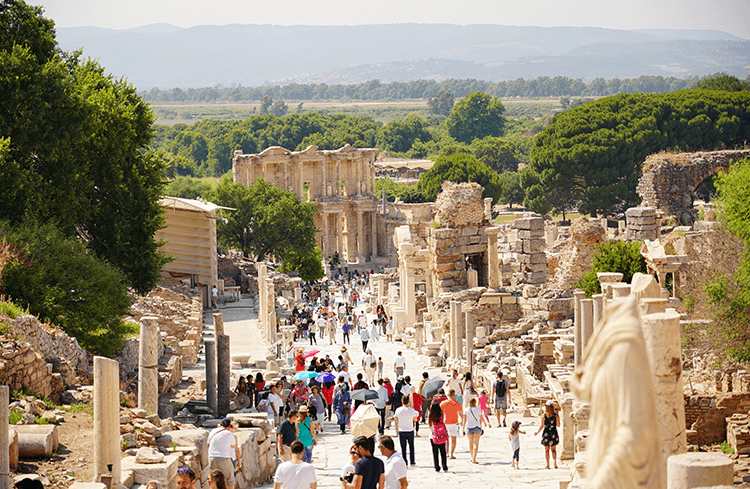One of the most renowned old cities in Turkey is Ephesus, one of the biggest and most spectacular ancient towns in the entire globe. Its placement on the 2015 list of UNESCO World Heritage Sites recognised its cultural and historical significance. The city’s ruins are situated near the lovely towns of Selcuk and Sirince and just 80 kilometres inland from the well-known seashore city of Izmir.
We offer turkey visa online to Turkey for your desired tour, from romantic honeymoons to scenic self-drive road trips to significant destinations.
A Brief History:
Although Ephesus has been a city since the Neolithic period, it achieved its greatest renown during the Roman Empire when it served as Asia Minor’s capital. Ephesus expanded and flourished, becoming the second-most significant city in the Roman Empire. Its inhabitants were primarily well-educated and wealthy, and its buildings were lavishly decorated and celebrated its citizens’ passions and good fortune. Visitors still come today to witness the city’s impressive historical legacy.
The legendary Temple of Artemis, one of the Seven Wonders of the Ancient World, was built by the ancient Greeks, who gave the city its rise to fame. Even though there is currently only one column left from the Temple, it was formerly thought to be very big and beautiful.
Ephesus underwent ups and downs in its fortunes before becoming a Roman city in 133 BC and Asia Minor’s capital in 27 BC. This was a turning point in the city’s history since it flourished and grew to be second only to Rome in terms of importance within the enormous Roman Empire.
Another significant location for the history of Christianity in the area is Ephesus. Paul the Apostle wrote his “First Letter to the Corinthians” here, while John the Baptist is credited with writing the Gospel. St. Mary’s Basilica at Ephesus, which is thought to be the final lying place of Mary, is among the most popular tourist attractions.
One of the largest and most significant Roman cities, Ephesus, is currently being unearthed and studied. The grandeur of the old city will leave visitors to the site stunned.
Library of Celsus
One of Ephesus’ most stunning buildings is the Library of Celsus, whose facade was carefully rebuilt from ancient pieces and towers over the city. It was constructed in 125 AD in honour of Tiberius Julius Celsus Polemaeanus, an Ancient Greek who presided as the Roman Empire’s governor of Roman Asia from 105 to 107 AD. Celsus is buried in a coffin below the library and uses his funds to pay for its construction.
The Amphitheatre
With a capacity of 25.000, the spectacular open-air theatre is thought to be the biggest in antiquity. There is evidence that it was first employed for dramatic performances and later for gladiatorial combat.
The Odeon
One of the finest architectural wonders of ancient Athens is the Odeon, a small, roofed theatre that Publius Vedius Antoninus and his wife built around 150 AD. The Odeon had about 1500 seats and presented plays and concerts. The stage stairs are still visible, and the building has red granite pillars in the Corinthian style.
Temple of Hadrian
The Temple of Hadrian was initially built in the second century, underwent repairs in the 4th century, and was eventually rebuilt using surviving architectural pieces to construct the structure that is still standing today. The Ephesus Archaeological Museum is where the originals are housed.
The Temple of the Sebastoi
This Temple, one of the biggest in the city and also known as the Temple of Domitian, was dedicated to the Flavian dynasty. The Temple was initially devoted to Domitian, who became the emperor, but Vespasian, Domitian’s father, was later honoured. The stairs can still be seen today, indicating the grandiosity of the structure.
Aqueducts
One of the most sophisticated aqueduct networks in antiquity was found in Ephesus. A saw mill and several spa facilities were among the parts of the city that were served by at least six aqueducts of varied sizes.
Agoras
Ephesus was a wealthy city with many agoras, some for selling daily goods and others for more essential state matters. Numerous agoras that have been meticulously maintained and rebuilt may be found all over the grounds.
St. John’s Basilica
During the 6th century Ad, Emperor Justinian I constructed this basilica. This ancient church is said to have been built on St. John’s tomb and is located close to Selcuk.
These are only a few sights among Ephesus’ countless riches. Find your favourite site right now!
You must have a reason to apply for a turkey visa online now. Visit our website and apply for a turkey e-visa online.
